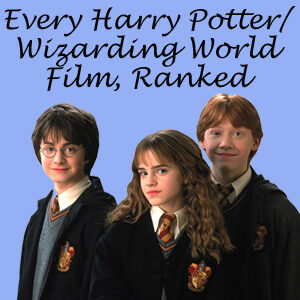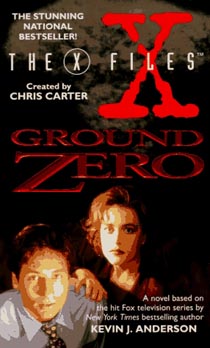After two mediocre novels from Charles Grant, the “X-Files” book series turns things around in a big way with “Ground Zero” (1995). Remarkably, this book is by Kevin J. Anderson, who around the same time was writing four “Star Wars” novels (the “Jedi Academy Trilogy” and “Darksaber”) that haven’t aged nearly as well. But for whatever reason, the author understands “The X-Files” whereas he didn’t quite grasp “Star Wars.” (Spoilers follow.)
“Ground Zero,” which would become so well-liked by fans that Topps Comics did a four-issue adaptation, is a meatier novel than Grant’s works. The paperback is 292 pages, and Anderson gives a damning critique of the U.S. nuclear weapons program through the years. The vengeance-seeking villain is Ryan Kamida, who was the lone survivor of a U.S. nuclear test that wiped out a whole civilization on Enika Atoll in the Fifties. Although this is a fictional story about a made-up island, the U.S. government really did relocate the population of Bikini Atoll for the sake of a nuclear test. And, of course, the horrors of Hiroshima and Nagasaki are well documented.
Some readers found it controversial that Anderson uses Scully as a lens through which nuclear weapons are explored. We learn in “Ground Zero” that Scully attended Cal-Berkeley in her freshman year of college and got involved with an anti-nuke protest group, something that led to heated arguments with her military dad. Until this story, even Mulder didn’t know she attended Cal. While that seems like a big piece of backstory to be revealed in a book rather than the TV series proper, it hasn’t been contradicted, so I’ll consider it to be canon until Chris Carter says otherwise.
More anti-nuke views come from Miriel Bremen, a former nuclear research scientist turned professional protester. She’s an example of who Scully could’ve become, and she challenges a reader to ask if Scully chose the right path. As Miriel notes, Scully works for the same government that is conducting the Bright Anvil test – again, on Enika Atoll – so why should she trust her? Mulder runs into the same awkward question from an alien abductee in the first episode of the 2016 miniseries. Mulder and Scully investigate the very government they work for. As we’ve seen, they learn a lot of things through their FBI jobs, but whether they can do anything about it is another matter.
Indeed, in “Ground Zero,” they observe the Bright Anvil test – and the supernatural explosion that goes with it, caused by Kamida’s vengeful, ghostly relatives – but can’t do anything to stop it. And, as is often the case, Skinner declines to take the agents’ report seriously, as he is no doubt answering to his off-screen (or off-page) bosses.
Another point of view comes from gruff nuke tester Bear Dooley, who argues that he is not morally responsible for what the military might do with the bombs he helps create. He says everyone has their area of expertise, and his expertise is not military strategy. It’s amusing that Mulder and Scully exchange “amazed” looks when Bear ends a rant with “You have to trust the government. They know what’s best for us” (page 246). More often, people who distrust the government are portrayed as extremists, so it’s a refreshing change.

Although a much better book overall, “Ground Zero” has a similar problem to Grant’s “Whirlwind” in that the description of every death is similar. The victim (always someone involved with the nuclear weapons program) receives a packet of ash, they feel a hot wind and they are roasted in a contained nuclear blast. Except that one pair of victims – missileers in a control bunker – DON’T receive a packet of ash. That wrinkle held my interest, but the revelation is weak. It turns out that Kamida’s ghost relatives don’t need the ash as a way to find the enemies after all; it’s a way for Kamida to guide them to their targets, but it isn’t essential.
Another oddity is that Miriel recounts the story of the USS Indianapolis as part of her diatribe against nuclear weapons, as that ship was involved in the delivery of the Hiroshima bomb. Most readers will think of Quint’s famous USS Indianapolis monologue from “Jaws,” so it’s odd that Anderson would invite a comparison he can’t possibly win.
Embracing the unlimited budget of his imagination, Anderson plays out “Ground Zero” on a bigger stage than most standalone episodes of the show. Mulder and Scully follow the case from D.C. to the Bay Area to New Mexico, then back to the Bay Area, then to Maryland, then back to California, then to Hawaii, then to the island where the test takes place. (And all this travel money is spent for the government to investigate – and exonerate – itself. I’ll try not to think about that too hard.)
One weak spot of “Ground Zero” is that after a while Anderson fails to surprise a reader; this trait is also found in his “Star Wars” entries. He makes up for it a bit with strong descriptions of the climactic typhoon and nuclear blast, but there’s still a sense of “Get to the end already.” Still, the buildup is enjoyable, and after the first two “X-Files” books, it’s refreshing to get a novel with the layered theme of nuclear warfare and a surprising slice of backstory for Scully. Anderson proves that “The X-Files” can work well in a medium other than TV.

